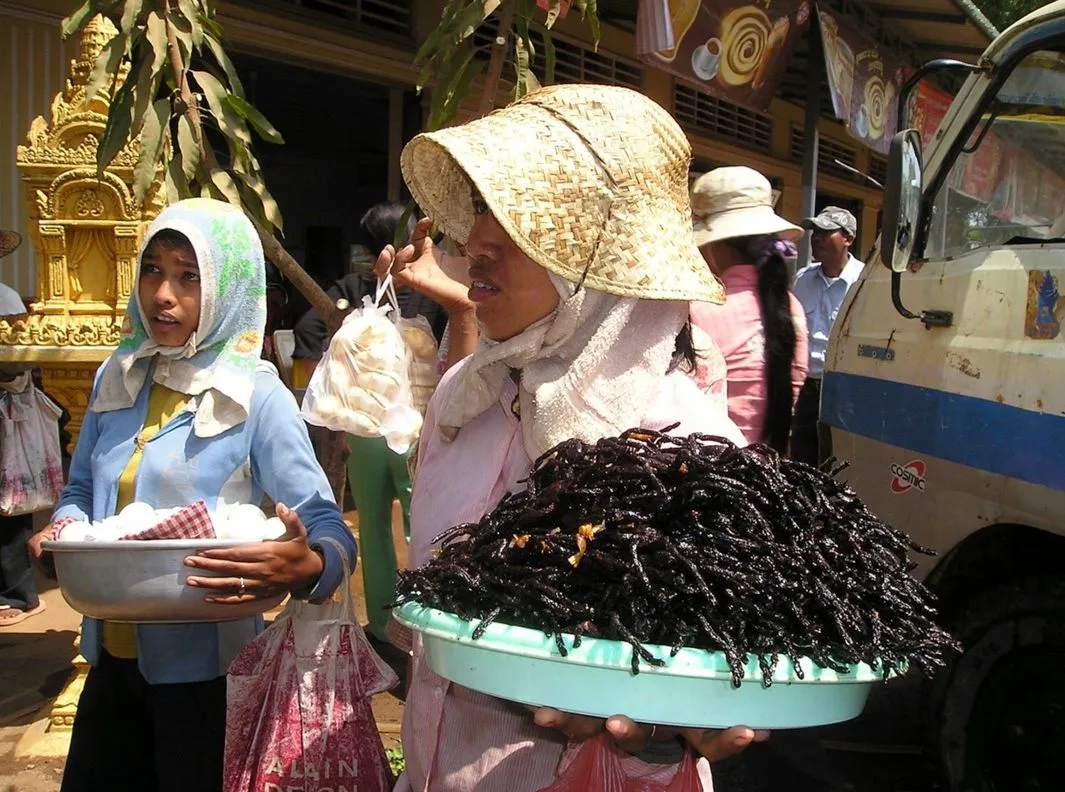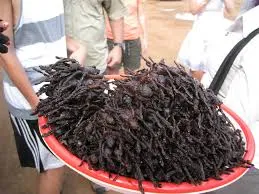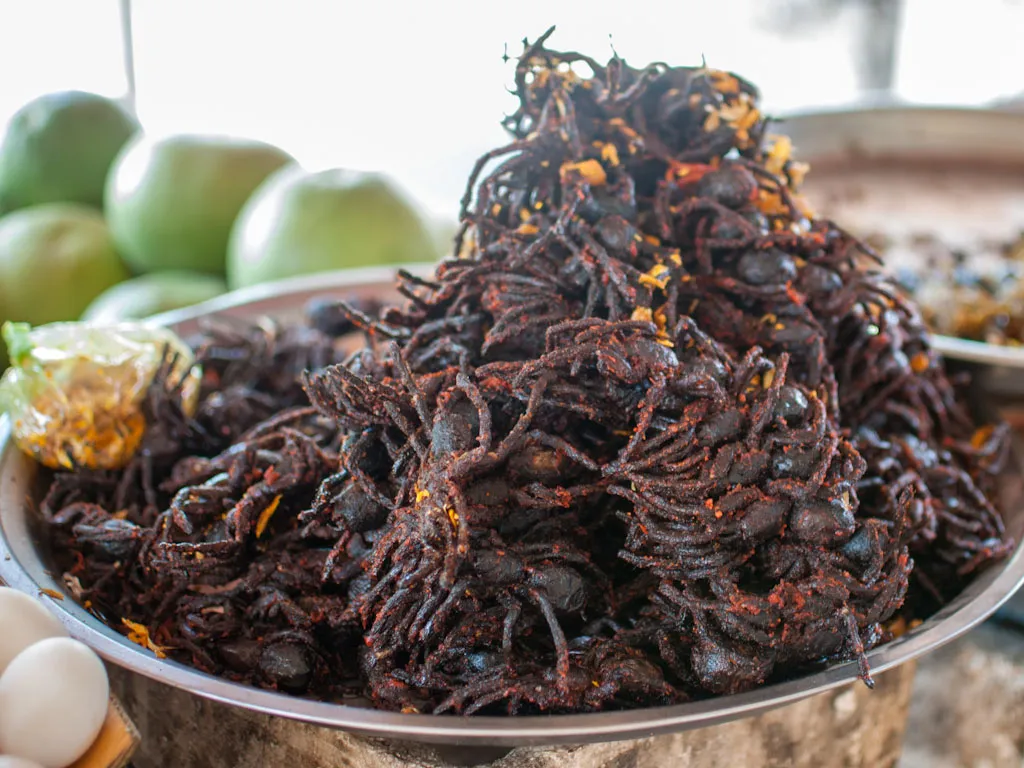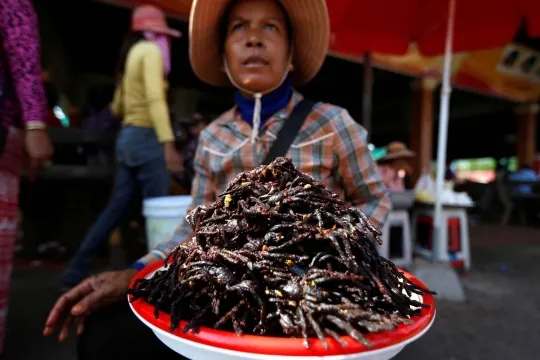What is Tarantula Goreng?
Tarantula Goreng, or fried tarantula, is a delicacy in Cambodia, particularly in the town of Skuon. It’s a dish of deep-fried tarantulas, seasoned with salt, sugar, and garlic. The spiders are typically about the size of a human hand, and they’re cooked whole, offering a unique and somewhat intimidating culinary experience. The practice of eating tarantulas in Cambodia has historical roots, emerging during times of food scarcity. Today, it has evolved into a popular street food and a tourist attraction, showcasing the country’s diverse and adventurous cuisine. This dish is not just about survival; it’s a cultural emblem, reflecting a connection to the land and a resourceful approach to food. It’s a testament to human adaptability and the willingness to embrace unconventional flavors and textures.
The Origins of Tarantula Goreng
The consumption of tarantulas in Cambodia has its roots in a complex interplay of environmental, economic, and historical factors. During the Khmer Rouge regime, when food was scarce and survival was paramount, people turned to various unconventional food sources, including spiders. This necessity-driven practice evolved into a cultural norm, particularly in the areas where tarantulas were abundant. The spiders, readily available in their natural habitat, became a source of sustenance. The adaptation of the people to consume these creatures demonstrated resilience and resourcefulness in the face of extreme adversity. After the regime, the practice not only continued but also transformed, becoming part of the local cuisine. Today, the dish is a symbol of resilience and cultural heritage, with a unique flavor and texture that attracts both locals and tourists.
Benefits of Eating Tarantula Goreng

Tarantula Goreng, while an unusual dish for many, offers several nutritional benefits that are often overlooked. It’s a source of various essential nutrients, including proteins, minerals, and chitin, which can contribute positively to one’s diet. The consumption of insects, including tarantulas, is also considered a sustainable food practice, contributing to environmental well-being. Furthermore, it represents a unique culinary experience, adding diversity to your diet. This exotic food is not just a novelty but can also offer several health and environmental advantages. Considering the nutritional profile and the potential impact on the environment, it is increasingly appealing to those seeking alternative and sustainable food sources. This section will delve into the specifics of these benefits.
High Protein Content
One of the most significant benefits of tarantula goreng is its high protein content. Protein is essential for building and repairing tissues, producing enzymes and hormones, and supporting overall health. The amino acids in the protein from tarantulas are similar to those found in other animal proteins, making it a complete protein source. For those seeking to increase their protein intake, tarantula goreng can be a valuable addition to the diet, contributing to muscle growth, weight management, and improved metabolic function. The relatively high protein content in comparison to other insects makes it a nutritional powerhouse, especially in regions where traditional protein sources are scarce or expensive. This makes it an attractive alternative to more common protein sources.
Rich in Essential Nutrients
Beyond protein, tarantula goreng is rich in various essential nutrients. It provides vitamins and minerals that are vital for optimal health and bodily functions. Tarantulas can contain iron, which is crucial for oxygen transport in the blood, and zinc, which supports immune function and wound healing. Additionally, they offer essential fatty acids, contributing to heart health and brain function. The specific nutritional profile can vary based on the tarantula species and its diet, but generally, they provide a good source of micronutrients. These nutrients help to maintain overall well-being, supporting various bodily functions and potentially reducing the risk of nutrient deficiencies. The diversity of nutrients in tarantula goreng makes it a relatively balanced food source.
Source of Chitin

Tarantula goreng is a significant source of chitin, a polysaccharide found in the exoskeleton of insects. Chitin has various health benefits, including aiding digestion and supporting gut health. It acts as a dietary fiber, promoting regularity and reducing constipation. Research also suggests that chitin may have positive effects on cholesterol levels and the immune system. While the exact health impact of chitin consumption is still being studied, its presence in tarantula goreng adds another layer of nutritional value. The fiber content contributes to the overall health benefits associated with eating the insects. This highlights another way the dish can be incorporated into a healthy diet.
A Sustainable Food Source
Eating tarantula goreng and other insects is considered a sustainable food source. Insect farming has a much lower environmental impact than traditional livestock farming. Insects require less land, water, and feed to produce the same amount of protein, reducing greenhouse gas emissions and the strain on natural resources. It offers a more eco-friendly way to obtain protein and other nutrients, making it a valuable option for those seeking to reduce their environmental footprint. By choosing insects, consumers are supporting a more sustainable food system. This can contribute to long-term environmental conservation. It offers a pathway to a more sustainable future.
Cultural Significance and Culinary Experience
Eating tarantula goreng is an important part of Cambodian culture and offers a unique culinary experience. It is not just a food; it is a cultural emblem that represents resourcefulness and a connection to the land. It allows people to explore and embrace diverse flavors. The act of eating tarantula goreng also promotes cultural exchange and understanding. It’s a conversation starter and a memorable experience, especially for tourists who are looking to try something new. The practice of eating tarantula goreng can deepen their appreciation for different ways of life. It provides an opportunity for personal growth and opens minds to the culinary world. It represents a deep cultural connection.
Preparing and Cooking Tarantula Goreng

Preparing tarantula goreng involves several steps, from sourcing the spiders to the actual cooking process. The methods used often vary depending on the region and personal preferences, but the goal remains the same to create a crispy, flavorful dish. The preparation process can significantly affect the taste and texture of the final product. Proper preparation is essential to ensure both the safety and enjoyment of the meal. This section will provide an overview of the key steps involved in preparing and cooking tarantula goreng, including sourcing, cleaning, and cooking methods.
Sourcing and Preparation
Sourcing tarantulas typically involves either catching them in the wild or purchasing them from local suppliers. The spiders are often sourced from areas where they are abundant. Before cooking, the tarantulas are cleaned, typically by removing the fangs and any unwanted body parts. They might be marinated in a mixture of spices, such as salt, sugar, and garlic, to enhance the flavor. Preparing the spiders correctly is crucial for ensuring both the flavor and safety of the dish. The process of cleaning and preparing tarantulas requires attention to detail and adherence to traditional practices. Preparation is a critical aspect of the cooking process.
Cooking Methods
The primary cooking method for tarantula goreng is deep-frying. The spiders are deep-fried in hot oil until they are crispy. The cooking process typically takes a few minutes, and the goal is to achieve a golden-brown color and a crunchy texture. In some cases, the tarantulas might be boiled or steamed before frying to ensure they are fully cooked and tender. Frying is often accompanied by seasoning the spiders with ingredients like salt, sugar, and garlic. Cooking methods can affect both the texture and taste of the finished dish. The cooking method plays a key role in preparing this exotic dish.
Where to Find Tarantula Goreng

The best place to find tarantula goreng is in Cambodia, particularly in the town of Skuon. You can often find it at local markets, street food stalls, and restaurants. While traveling to Cambodia is the most direct way to sample this delicacy, it may be possible to find it in some specialty food stores or online retailers that specialize in exotic foods. The availability of tarantula goreng can vary depending on the season and local regulations. The best chance to experience this dish is by visiting the regions where it’s a traditional part of the cuisine. This unique food can provide a culinary adventure and an understanding of different cultures.
